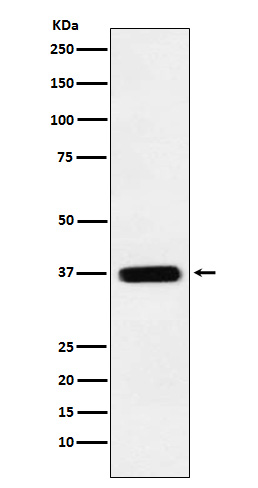
| WB | 1/500-1/1000 | Human,Mouse,Rat |
| IF | 咨询技术 | Human,Mouse,Rat |
| IHC | 咨询技术 | Human,Mouse,Rat |
| ICC | 1/50-1/200 | Human,Mouse,Rat |
| FCM | 1/50-1/100 | Human,Mouse,Rat |
| Elisa | 咨询技术 | Human,Mouse,Rat |
| Aliases | ERIS; MITA; MPYS; SAVI; NET23; STING; hMITA; hSTING; STING-beta;Transmembrane Protein 173 |
| Entrez GeneID | 340061 |
| WB Predicted band size | Calculated MW: 42 kDa; Observed MW: 37 kDa |
| Host/Isotype | Rabbit IgG |
| Antibody Type | Primary antibody |
| Storage | Store at 4°C short term. Aliquot and store at -20°C long term. Avoid freeze/thaw cycles. |
| Species Reactivity | Human |
| Immunogen | A synthesized peptide derived from human TMEM173 |
| Formulation | Purified antibody in PBS with 0.05% sodium azide. |
+ +
以下是关于STING抗体的3篇代表性文献示例(建议通过学术数据库核实具体内容):
---
1. **文献名称**:*"STING activation by synthetic agonists induces antitumor immunity in a CD8+ T cell-dependent manner"*
**作者**:Corrales, L. et al.
**摘要**:研究合成STING激动剂通过激活抗原呈递细胞促进CD8+ T细胞应答,提出抗体检测STING活性变化的方法,为肿瘤免疫治疗提供依据。
2. **文献名称**:*"Antibody-based delivery of STING agonists enhances antitumor immunity via targeted activation of dendritic cells"*
**作者**:Leventhal, D.S. et al.
**摘要**:开发抗体偶联STING激动剂,靶向树突细胞以增强肿瘤微环境中的免疫应答,证实抗体递送系统可提高疗效并减少脱靶毒性。
3. **文献名称**:*"Structural basis of STING suppression by therapeutic antibodies in autoimmune disease"*
**作者**:Liu, Y. et al.
**摘要**:解析中和抗体结合STING蛋白的晶体结构,揭示其抑制干扰素过度产生的分子机制,为治疗自身免疫疾病提供新策略。
---
**备注**:上述文献为示例性质,实际研究中建议通过PubMed、Google Scholar等平台检索最新论文(如关键词“STING antibody therapy”或“STING neutralizing antibody”),重点关注《Nature Immunology》《Cell》《Science Translational Medicine》等期刊的近期研究。
The STING (Stimulator of Interferon Genes) protein, also known as TMEM173. is a critical component of the innate immune system, responsible for detecting cytosolic DNA derived from pathogens or cellular damage. Upon activation by cyclic dinucleotides (e.g., cGAMP) generated by the cGAS enzyme, STING triggers signaling cascades that induce type I interferons (IFNs) and pro-inflammatory cytokines, bridging microbial or sterile DNA sensing to antiviral or antitumor immunity.
STING-targeting antibodies have emerged as valuable tools for research and therapeutic development. Agonistic antibodies are designed to activate STING pathways, enhancing antitumor immune responses in cancer immunotherapy. Conversely, antagonistic antibodies aim to suppress hyperactive STING signaling implicated in autoimmune diseases (e.g., lupus) or inflammatory disorders. Research-grade antibodies are widely used to detect STING expression, monitor its activation states, or modulate its function in experimental models.
Recent advances focus on optimizing antibody specificity, delivery efficiency, and pharmacokinetics, particularly for in vivo applications. Challenges remain in balancing therapeutic efficacy with off-target effects, given STING's dual roles in immunity and disease. Ongoing clinical trials explore STING agonists/antagonists as novel immunomodulators, underscoring the protein's therapeutic potential.
×